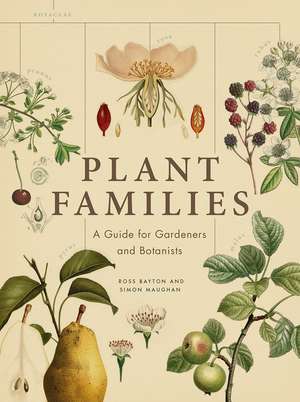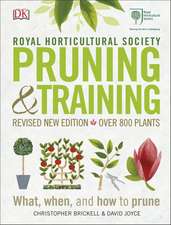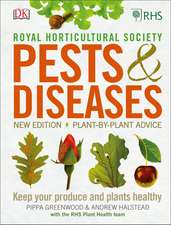Plant Families: A Guide for Gardeners and Botanists
Autor Ross Bayton, Simon Maughanen Limba Engleză Hardback – 7 oct 2017
Most of us lump plants together in one big family, and when pressed can only explain their grouping by what they’re not—not an animal, not a mineral, and so just a plant. In reality, there are hundreds of different plant families, each grouped logically by a unique family history and genealogy. This brings sense and order to the more than a quarter of a million different plant species covering a diverse spectrum that includes soaring sequoias (Cupressaceae), squat prickly pear (Cactaceae), and luxuriant roses (Rosaceae).
Plant Families is an easy-to-use, beautifully illustrated guide to the more than one hundred core plant families every horticulturist, gardener, or budding botanist needs to know. It introduces the basics of plant genealogy and teaches readers how to identify and understand the different structures of flowers, trees, herbs, shrubs, and bulbs. It then walks through each family, explaining its origins and range, and describing characteristics such as size, flowers, and seeds. Each family is accompanied by full-color botanical illustrations and diagrams. “Uses For” boxes planted throughout the book provide practical gardening tips related to each family.
We have much to gain by learning about the relationships between plant families. By understanding how botanists create these groupings, we can become more apt at spotting the unique characteristics of a plant and identify them faster and more accurately. Understanding plant families also helps us to make sense of—and better appreciate—the enormous biological diversity of the plant kingdom.
Plant Families is an easy-to-use, beautifully illustrated guide to the more than one hundred core plant families every horticulturist, gardener, or budding botanist needs to know. It introduces the basics of plant genealogy and teaches readers how to identify and understand the different structures of flowers, trees, herbs, shrubs, and bulbs. It then walks through each family, explaining its origins and range, and describing characteristics such as size, flowers, and seeds. Each family is accompanied by full-color botanical illustrations and diagrams. “Uses For” boxes planted throughout the book provide practical gardening tips related to each family.
We have much to gain by learning about the relationships between plant families. By understanding how botanists create these groupings, we can become more apt at spotting the unique characteristics of a plant and identify them faster and more accurately. Understanding plant families also helps us to make sense of—and better appreciate—the enormous biological diversity of the plant kingdom.
Preț: 169.52 lei
Nou
Puncte Express: 254
Preț estimativ în valută:
32.44€ • 35.23$ • 27.25£
32.44€ • 35.23$ • 27.25£
Carte disponibilă
Livrare economică 01-15 aprilie
Preluare comenzi: 021 569.72.76
Specificații
ISBN-13: 9780226523088
ISBN-10: 022652308X
Pagini: 224
Ilustrații: 300 color plates
Dimensiuni: 178 x 229 x 23 mm
Greutate: 0.7 kg
Ediția:1
Editura: University of Chicago Press
Colecția University of Chicago Press
ISBN-10: 022652308X
Pagini: 224
Ilustrații: 300 color plates
Dimensiuni: 178 x 229 x 23 mm
Greutate: 0.7 kg
Ediția:1
Editura: University of Chicago Press
Colecția University of Chicago Press
Notă biografică
Simon Maughan has worked as an editor and publisher for the Royal Horticultural Society for over twelve years, and is the author of RHS Botany for Gardeners.
Cuprins
Preface
Introduction
The plant family tree
From the first plants to flowers
Ferns—fronds to fiddleheads
Gymnosperms
Angiosperms
Monocotyledons (monocots)
Eudicotyledons (eudicots)
What to look for when identifying plants
The different plant types
Roots and stems
Leaves
Flowers
Fruits and seeds
Key to major groups
CHAPTER 1: GYMNOSPERMS
Cycadaceae, Stangeriaceae, and Zamiaceae (cycads)
Ginkgoaceae (ginkgo)
Araucariaceae (monkey-puzzle)
Podocarpaceae (podocarp)
Pinaceae (pine)
Cupressaceae (cypress)
Taxaceae (yew)
CHAPTER 2: MONOCOTS AND EARLY ANGIOSPERMS
Nymphaeaceae (waterlily)
Magnoliaceae (magnolia)
Araceae (arum)
Melanthiaceae (wake-robin)
Colchicaceae (autumn crocus)
Liliaceae (lily)
Orchidaceae (orchid)
Iridaceae (iris)
Amaryllidaceae (daffodil)
Asphodelaceae (daylily)
Asparagaceae (asparagus)
Arecaceae (palm)
Zingiberaceae (ginger)
Bromeliaceae (pineapple)
Poaceae (grass)
CHAPTER 3: EUDICOTS
Berberidaceae (barberry)
Papaveraceae (poppy)
Ranunculaceae (buttercup)
Crassulaceae (stonecrop)
Hamamelidaceae (witch hazel)
Paeoniaceae (peony)
Saxifragaceae (saxifrage)
Euphorbiaceae (spurge)
Salicaceae (willow)
Violaceae (violet)
Fabaceae (legume)
Moraceae (mulberry)
Rosaceae (rose)
Begoniaceae (begonia)
Cucurbitaceae (squash)
Betulaceae (birch)
Fagaceae (oak)
Juglandaceae (walnut)
Geraniaceae (cranesbill)
Myrtaceae (myrtle)
Onagraceae (evening primrose)
Sapindaceae (maple)
Rutaceae (citrus)
Malvaceae (mallow)
Cistaceae (rock rose)
Brassicaceae (cabbage)
Amaranthaceae (amaranth)
Cactaceae (cactus)
Caryophyllaceae (carnation)
Droseraceae (sundew)
Polygonaceae (rhubarb)
Cornaceae (dogwood)
Hydrangeaceae (hydrangea)
Ericaceae (heather)
Primulaceae (primrose)
Theaceae (camellia)
Convolvulaceae (morning glory)
Solanaceae (nightshade)
Apocynaceae (milkweed)
Gentianaceae (gentian)
Lamiaceae (mint)
Oleaceae (olive)
Scrophulariaceae (figwort)
Plantaginaceae (plantain)
Boraginaceae (borage)
Asteraceae (daisy)
Campanulaceae (bellflower)
Apiaceae (carrot)
Araliaceae (aralia)
Adoxaceae (elder)
Caprifoliaceae (honeysuckle)
Bibliography
Index
Credits
Introduction
The plant family tree
From the first plants to flowers
Ferns—fronds to fiddleheads
Gymnosperms
Angiosperms
Monocotyledons (monocots)
Eudicotyledons (eudicots)
What to look for when identifying plants
The different plant types
Roots and stems
Leaves
Flowers
Fruits and seeds
Key to major groups
CHAPTER 1: GYMNOSPERMS
Cycadaceae, Stangeriaceae, and Zamiaceae (cycads)
Ginkgoaceae (ginkgo)
Araucariaceae (monkey-puzzle)
Podocarpaceae (podocarp)
Pinaceae (pine)
Cupressaceae (cypress)
Taxaceae (yew)
CHAPTER 2: MONOCOTS AND EARLY ANGIOSPERMS
Nymphaeaceae (waterlily)
Magnoliaceae (magnolia)
Araceae (arum)
Melanthiaceae (wake-robin)
Colchicaceae (autumn crocus)
Liliaceae (lily)
Orchidaceae (orchid)
Iridaceae (iris)
Amaryllidaceae (daffodil)
Asphodelaceae (daylily)
Asparagaceae (asparagus)
Arecaceae (palm)
Zingiberaceae (ginger)
Bromeliaceae (pineapple)
Poaceae (grass)
CHAPTER 3: EUDICOTS
Berberidaceae (barberry)
Papaveraceae (poppy)
Ranunculaceae (buttercup)
Crassulaceae (stonecrop)
Hamamelidaceae (witch hazel)
Paeoniaceae (peony)
Saxifragaceae (saxifrage)
Euphorbiaceae (spurge)
Salicaceae (willow)
Violaceae (violet)
Fabaceae (legume)
Moraceae (mulberry)
Rosaceae (rose)
Begoniaceae (begonia)
Cucurbitaceae (squash)
Betulaceae (birch)
Fagaceae (oak)
Juglandaceae (walnut)
Geraniaceae (cranesbill)
Myrtaceae (myrtle)
Onagraceae (evening primrose)
Sapindaceae (maple)
Rutaceae (citrus)
Malvaceae (mallow)
Cistaceae (rock rose)
Brassicaceae (cabbage)
Amaranthaceae (amaranth)
Cactaceae (cactus)
Caryophyllaceae (carnation)
Droseraceae (sundew)
Polygonaceae (rhubarb)
Cornaceae (dogwood)
Hydrangeaceae (hydrangea)
Ericaceae (heather)
Primulaceae (primrose)
Theaceae (camellia)
Convolvulaceae (morning glory)
Solanaceae (nightshade)
Apocynaceae (milkweed)
Gentianaceae (gentian)
Lamiaceae (mint)
Oleaceae (olive)
Scrophulariaceae (figwort)
Plantaginaceae (plantain)
Boraginaceae (borage)
Asteraceae (daisy)
Campanulaceae (bellflower)
Apiaceae (carrot)
Araliaceae (aralia)
Adoxaceae (elder)
Caprifoliaceae (honeysuckle)
Bibliography
Index
Credits
Recenzii
“An amazing guide filled with botanical information and exacting illustrations and diagrams.”
“Examines the major families of the plant world. . . . For each included family, information is provided on family origins, morphology, and ornamental or agricultural uses for members of the family. Elegant color illustrations throughout highlight important terms, structures, and example species associated with each plant family.”
“A visually engaging introduction to systematics that would make a perfect gift or decorative tabletop book for almost any level of budding horticulturist. Its beauty does not detract from the bite-sized knowledge that it imparts, but rather works well to pull in the novice reader and maybe even attract a few future botanists.”




















